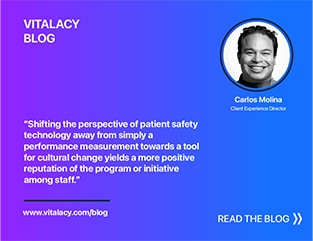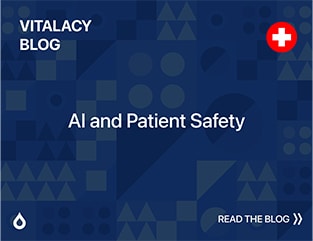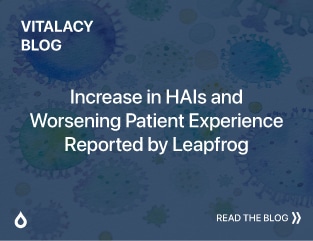“People don’t realize the toll [the pandemic has] taken on the infectious disease response folks,” said infectious disease epidemiologist and infection preventionist (IP) Saskia Popescu in a recent Huffington Post article (Wong, 2022). Having experienced vitriol from people against scientists, Popescu remains committed to applying the infection prevention and control (IPC) lessons learned during the COVID pandemic to better mitigate and prepare for emerging infectious disease.
She is not alone. Many other infection preventionists remain committed to their careers, but they need help. The long hours and other stresses caused by the COVID pandemic resulted in high burnout within the IP ranks. Burnout coupled with a pandemic environment requiring even more IPs has resulted in a national shortage of these valuable specialists.
In response, IPC leaders are doing what they do best – responding to a difficult situation with ingenuity and resourcefulness. Vitalacy team members who attended the recent Association for Professionals in Infection Control and Epidemiology (APIC) Annual Conference in Indianapolis compiled the advice included in this article from conference presentations and other reports.
Finding and training new IPs
A recipient of the Heroes of Infection Prevention Award from APIC, Kelley Knapek of the Good Samaritan Medical Center in Lafayette, Colorado, was placed in charge of her hospital system’s infection preventionist training program. According to a story in the June 14 #APIC2022 Daily News, she didn’t expect to be opening the door to a new career for so many passionate, yet under-experienced, individuals. “The main roadblock into getting into IPC is that there is no clear first step,” Knapek stated.

Young woman doing homework at night.
Knapek found value in being open-minded about potential candidates. “You’ll want to open the call for new IPs to everyone in your facility because you don’t know who is interested,” she explained. She found personality type to be more important than professional background. “You can train a skill, but not a personality. The ideal IP will be curious and willing to learn how to ask the right questions.” This careersinpublichealth.net article provides more information about what it takes to be an infection preventionist.
Knapek expanded upon APIC’s Roadmap for the Novice Infection Preventionist to develop a tailored training program for her hospital system. She expanded on the roadmap by adding details specific to her institution, creating a comprehensive plan that included what she learned as a novice infection preventionist, such as the importance of relationship building.
During the height of the COVID-19 pandemic, Good Samaritan hired five new IPs, either with little or zero infection prevention and control experience. Due to the success of Knapek’s training program, they have become comfortable on the job, and some are now studying for their Certification in Infection Control (CIC) exam.
Tapping into networks
When COVID hit Indiana, state public health worker Jennifer Spivey stated that “I knew that I wasn’t going to be able to find experienced CICs. Featured in a June 15 #APIC2022 Daily News article, Spivey said she “reached out to my networks. What was most important was the leadership abilities of these individuals. I needed independent thinkers with multidisciplinary clinical backgrounds” who also possessed soft skills such as empathy. Spivey and her leaders trained the new IPs on specific skills and had them take training courses produced by the Centers for Disease Control and Prevention (CDC) or the University of Indiana.
Retired infection preventionists also were called back to duty. Ascension Texas put retired IPs to work in remote centralized surveillance support to increase the capacity of hospital-based IPs (Meara, 2021). Particularly in departments with lean staffing, reducing the surveillance burden eased the training demand of new IPs and supported the retention of new staff.
Enlisting IP champions stretches resources
O’Connor Hospital’s skilled nursing facility in Santa Clara County, California, hired infection preventionist Jeffrey Mantes to teach best IPC practices to all staff and to enlist frontline champions on every shift to help ensure consistent implementation of infection prevention protocols throughout the facility. These protocols included hand hygiene, PPE donning and doffing, and catheter-associated urinary tract infection prevention practices.
“Our IP champions perform daily hand hygiene and Foley bundle audits and correct any identified non-compliant elements in real time to ensure patient and staff safety are maintained,” said Mantes in a June 14 #APIC2022 Daily News article. The hospital’s infection control manager Priya Pandya-Orozco said “Jeffrey was visible on the floor, doing ‘just-in-time’ training and daily rounding. He always made sure staff understood the rationale behind the training.”
Making the case
During her presentation at APIC22, Annemarie Flood, executive director of quality and infection prevention at City of Hope in Duarte, California, spoke of the importance of collecting data on your facility’s infection prevention requirements. These data enable IP leaders to advocate for necessary staff.
According to an article in the June 14 #APIC2022 Daily News, Flood recommended gathering data and information on the institutional goals that require IP participation, new or planned acquisitions or expansions requiring IPs, professional development opportunities, and all activities relating to the job including rounding, driving to clinical sites and administrative tasks.
After gathering all of this information, Flood calculated how many full-time equivalents (FTEs) would be needed to meet all requirements and activities. She presented to leadership and was able to gain one more IP, increasing her staff to four FTEs. “By spending a few days you can shape the resource of your program of the future,” she said.
Educating via social media
At the beginning of the COVID pandemic, Katrine Wallace, an epidemiologist at the University of Illinois at Chicago’s School of Public Health, was scrolling through social media in search of entertainment during the shutdown. In addition to seeing posts about people’s kids, food and pets, she began to notice a lot of COVID misinformation. “Motivated by a sense of duty as an epidemiologist and public health professor, I started to make my own social media content to debunk the nonsense and teach evidence-based information,” she stated in a recent Huffington Post article (Wong, 2022).
Today, her TikTok page has more than 260,000 followers. “I have built a community that trusts me and relies on me for evidence-based information, misinformation debunking and advice, and I take that responsibility seriously. It’s like having a very busy second job that I don’t get paid for,” she stated.
Vitalacy’s Automated Hand Hygiene Compliance Monitoring Solution helps infection preventionists to save time and resources while protecting patients and staff from infectious disease. Providing more accurate and comprehensive hand hygiene compliance information than direct observation, the solution was recognized by Newsweek’s Best of HealthCare as one of the best monitoring products for infection prevention. The solution’s 24/7 capabilities enable hospitals to meet Leapfrog Group standards while providing budget-friendly and upgradable options.
Request a demo today to learn more about a Vitalacy solution that will work best for your organization.
References
#APIC2022 Daily News. Recruit, train, and retain: An IP-developed program for the future, Issue 3, June 14, 2022.
#APIC2022 Daily News. Proving the value of adding a full-time infection preventionist: California skilled nursing facility reports infection prevention improvements during pandemic, Issue 3, June 14, 2022.
#APIC2022 Daily News. How to collect and use data when making the case to hire more IPs, Issue 3, June 14, 2022.
#APIC2022 Daily News. From 0 to 60: Building an IP team in a pandemic, Issue 4, June 15, 2022.
Meara K. Using retired infection preventionists to address staffing shortages. Contagion Live, June 29, 2021.
Wong B. There are millions of people who can’t just “move on” from COVID. Huffington Post, June 15, 2022
Author
-

Janel Nour-Omid was inspired to start Vitalacy after losing her grandfather to a Healthcare-Acquired Infection. Through her background in computer science and product development and deep fascination in human behavior, she launched the Vitalacy platform designed to protect caregivers and patients from preventable infections and conditions. She was recognized in Forbes 30 Under 30 in Healthcare in 2020.



